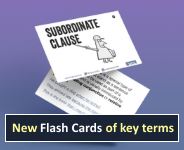Glossary: compound
Explanation
A compound word contains at least two root words in its morphology; e.g. whiteboard, superman.
Compounding is very important in English.
- blackbird, blow-dry, bookshop, ice-cream, English teacher, inkjet, one-eyed, bone-dry, baby-sit, daydream, outgrow
A root word is also known as a lexical base. Compounds are written in different ways: sometimes as one word, sometimes hyphenated, and sometimes as separate words. A neoclassical compound is a compound consisting of two combining forms derived from classical languages, e.g. bio- + -graphy.
Englicious contains many resources for English language in schools, but the vast majority of them require you to register and log in first. For more information, see What is Englicious?

